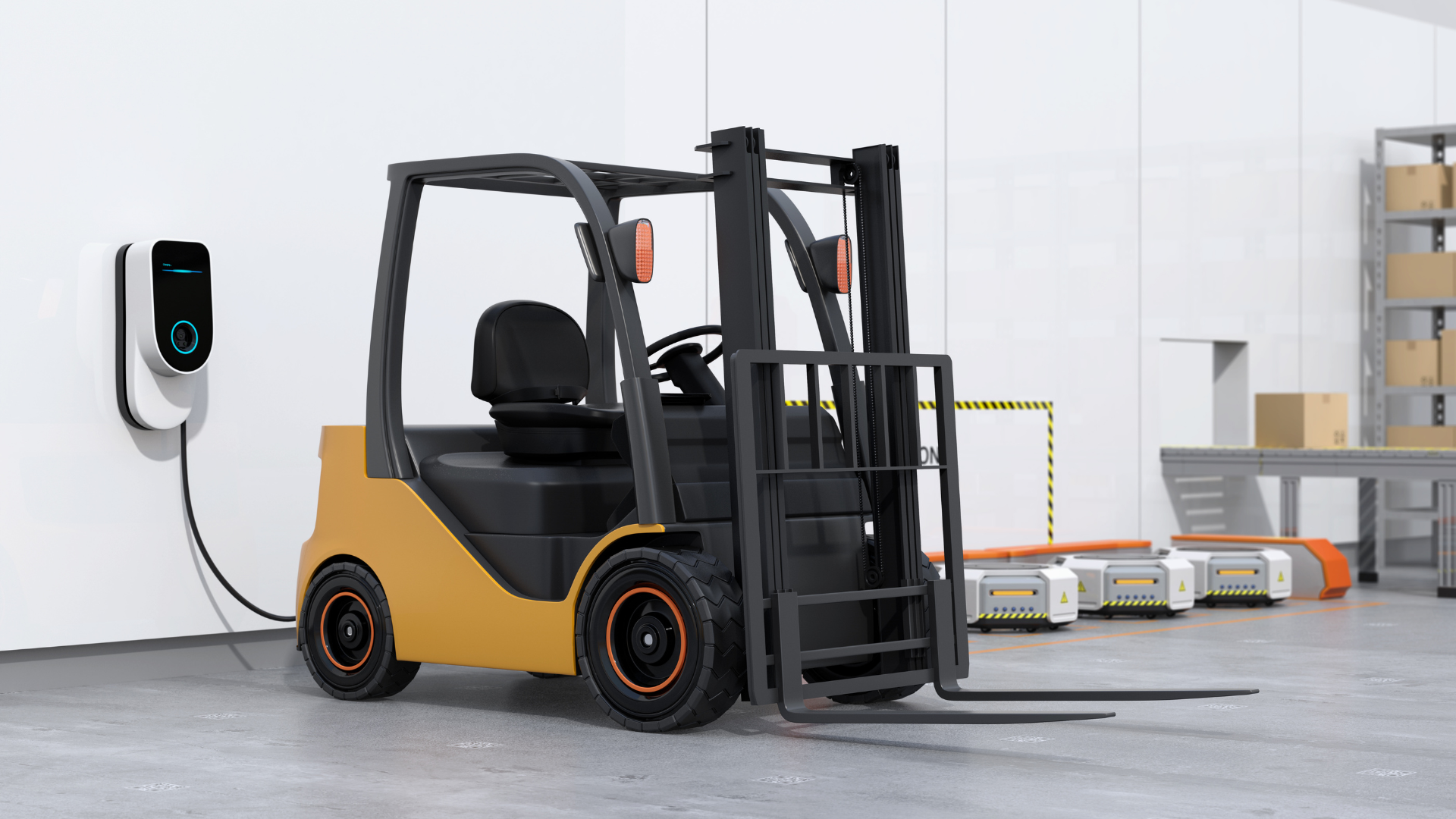During the design process of automated guided vehicles (AGVs) and autonomous mobile robots (AMRs) for warehouses, OEMs must determine the optimal on-board charge coupling option by balancing various trade-offs. This decision primarily involves the vehicle’s specific application and weighing costs against operational sophistication or power transfer efficiency (i.e., contact-based charging or wireless connection).
Generally, on-board wireless charging offers improved safety and simplicity at a higher cost—with the potential promise of fleet autonomy. Alternatively, traditional contact-based charging is more cost-effective and efficient in terms of power transfer; however, it may require more manual handling and may not be suitable for harsh environments. Below, we’ll thoroughly examine both to help OEMs and fleet managers with their decisions.
AGVs & AMRs—Types and Applications
Warehouse operations benefit significantly from integrating AGVs that accomplish simple and repetitive tasks when working alongside personnel. These machines can pick inventory, pack and route shipments appropriately, and more with little to no human intervention.
Moreover, fleet managers can choose from the numerous types of AGVs and AMRs to leverage different designs and capabilities best suited for their specific environments:
- Carts – The most basic AGV provides a flat surface on wheels to transport inventory.
- Towers and tractors – These vehicles can pull multiple carts (although this may require an automated system or manual intervention to hook up.
- Forklifts and pallet jacks – Forklifts will be able to reach and transport pallets at taller heights, whereas pallet jacks will be used for ground transportation around warehouses.
- Specialty vehicles – Certain environments will contend with additional constraints that may require specialized types of AGVs—such as narrow aisles that don’t allow much mobility—and AMRs—such as the terrain for last-mile delivery.
- Other utility vehicles – Not every AGV in a warehouse will directly contribute to operational throughput; for example, floor cleaners don’t transport inventory but will be needed to ensure other AGVs can traverse the warehouse without impacting debris.
General Considerations for AGV & AMR Charging
Regardless of the types of AGVs and AMRs fleet managers choose, the charging system and its capabilities should heavily affect their decision. All the other capabilities and specifications mean nothing if the vehicles’ charge duration can’t meet daily operational volume, charging takes too long, or a similar issue arises.
Selecting the right on-board charger for an AGV or AMR will be influenced by several factors:
- Charge Output Power/Voltage/Current – Choosing a charge coupling design is influenced by the power charger’s output (voltage requirements) and the ideal rate at which that exchange will occur (current). To that end, OEMs must consider factors like:
The battery pack voltage
Energy storage capacity
Targeted charge times (e.g., “overnight”)
- Energy efficiency – OEMs must decide whether convenience or energy efficiency is more important. For example, wireless charging offers convenience at a slightly sacrificed efficiency rate. But this efficiency loss depends on the distance between the vehicle and the charger and the wireless charging method. Small gap DC/DC is approximately 95%-98% as efficient as contact-based coupling designs, whereas large gap AC supply is approximately 75%-90% as efficient.
- On-board space constraints – The smaller size and high power density of lithium batteries have enabled the inclusion of on-board chargers—contact-based or wireless. However, compared to contact-based chargers, the wireless setup can be somewhat space-intensive, which may require sacrificing other functionalities or adding weight.
- Physical operation environment – Depending on the vehicle’s operational environment, contact-based or wireless charging may be superior for durability. For instance, wireless charging units may fare better in dirty, corrosive, or potentially explosive conditions, whereas contact-based solutions may be better suited to clean and safe environments.
- Autonomy – Wireless charging is the better option for transitioning towards autonomous operations because it does not require manual intervention from personnel to connect the vehicle to the charger. Along those lines, in warehouses where there are fewer staff members, wireless charging would be more practical as it would not require as much personnel attention.
- Telematics – An advantage of modern battery management systems (BMS) is the potential use for telematics data from battery charging and usage. But the reliability and speed of the wired or wireless communications system must align with the system’s requirements to support any real-time decision-making.
- Cost – On average, wireless charging will cost more than contact-based options. Wireless solutions provide a premium for convenience and other features, sometimes as much as 3x of the traditional options.
Contact-Based Charge Coupling Considerations
Generally, contact-based charge coupling systems tend to be more affordable, dependable, and energy-efficient. However, the specific type of contact-based coupling system can affect various performance aspects.
Typically, OEMs will select one of four options:
- Manual connection – Like most other electrical devices, a manual connection relies on someone physically plugging the charger into the vehicle and then unplugging it once recharged. This option relies on having the necessary personnel and centralized charging infrastructure.
- Guided plate-to-plate connections – A guided plate-to-plate connection is a more advanced charging method that’s integral to an autonomous contact-based charging system. This setup would allow vehicles to dock, charge, and uncouple without requiring direct human intervention, making it a more efficient and self-sufficient process.
- Automated connector systems – An automated connector, which is an even more advanced charging system, could be located on the vehicle or the charging station. This system would rely on advanced AI guidance, which would involve significant costs for research and development, testing, and implementation.
- Battery swapping – Traditionally, battery swapping was necessary with lead-acid batteries due to short cycles and cool-off periods, leading to a reduction of critical floor space within warehouses. While lithium batteries don’t require swapping, this process may be advantageous, particularly for usage scenarios that involve high-duty cycles. And depending on the OEM’s desires, this process could be conducted manually or fully automated.
Wireless Charge Coupling Considerations
Wireless chargers eliminate the need for a direct, physical connection between an AGV’s or AMR’s battery and the power sources used to charge it. This represents the future of electric vehicles, devices, and instruments, especially as the world transitions toward autonomous systems.
However, the technology is still in early development stages.
While there are several wireless charging methods, magnetic resonance is the most commonly used. However, various factors—such as resonance, coil size, coil gaps, and gap alignment—will impact the charger’s distance capabilities and transfer efficiency.
Typically, OEMs can opt for one of three electrical engineering configurations:
- Small gap – As the best option for low-cost, low-power wireless charging applications, small gaps maintain impressive efficiency without costing significantly more than contact-based counterparts. With this solution, the isolation transformer (the part used to convert electricity) would be separated into two parts—one off-board, the other on-board—to increase the allowable distance between the charger and the vehicle.
- Large gap charger – Like the small gap, a large gap charger separates electrical components between on-board and off-board, with the DC/DC converter staying on-board. While the larger coils and gaps allow for improved output and charge speeds, there is an efficiency drop-off and significant associated costs.
- Large gap AC supply – This follows a similar coil structure to the large gap charger, except it uses a contactless AC extension cord that connects to an off-board ground assembly. As this technology is in early stage development, it has even greater efficiency drop-offs and higher associated costs.
Evaluating the Tradeoffs of Wireless and Contact-Based Charging
Both contact-based and wireless charging have their advantages and disadvantages, and there are even more variations within those subcategories.
These considerations make it challenging for OEMs to decide which charging solution is best for their AGVs and AMRs, seeing as the right answer will depend on the vehicle’s specific needs, intended usage, and environment. Infrastructure and charging requirements should also be considered when making this decision.
Because there is no universal answer, OEMs developing AGVs and AMRs should carefully select a charge partner who can work with them to find the ideal coupling design best suited for their specific clientele.
Sources:
How-To Geek. Wi-Fi vs. Ethernet: How Much Better Is a Wired Connection? https://www.howtogeek.com/217463/wi-fi-vs.-ethernet-how-much-better-is-a-wired-connection/
Science Direct. Lithium-ion battery fast charging: A review. https://www.sciencedirect.com/science/article/pii/S2590116819300116
OSTI. Advances in High-Power Wireless Charging Systems: Overview and Design Considerations. https://www.osti.gov/pages/servlets/purl/1665984





